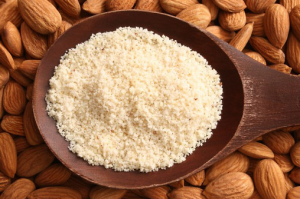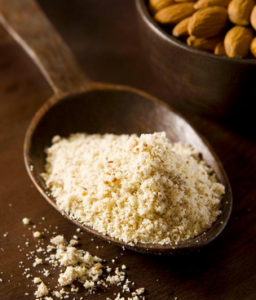
Almond flour is one of those Paleo ingredients that seems to show up in nearly every Paleo cookbook, website, and recipe. Is it automatically Paleo because it’s made from almonds? How do you know if you should (or should not) be eating it?
Nutritional Value of Almond Flour
Serving Size: 1/4 cup
- Calories: 160
- Calories from Fat: 120
- Fat: 14 g
- Fiber: 3 g
- Protein: 6 g
If you compare the nutrient profile for 1/4 cup of whole almonds, you will find it to be very similar to that of almond flour. This is because almond flour is simply whole almonds, ground into powder. There are a few different varieties, including almond meal (made with skin on the almonds; grainier, more coarse) and almond flour (made without the skin; finer).
 The nutrient benefits of almond flour include 40% of the Recommended Daily Allowance (RDA) of vitamin E, 7% of the RDA of calcium, and generous amounts of niacin, folate, phosphorous, potassium, zinc, and manganese. A 1/4 cup serving of almond flour contains approximately 23 almonds, which is approximately one serving of nuts.
The nutrient benefits of almond flour include 40% of the Recommended Daily Allowance (RDA) of vitamin E, 7% of the RDA of calcium, and generous amounts of niacin, folate, phosphorous, potassium, zinc, and manganese. A 1/4 cup serving of almond flour contains approximately 23 almonds, which is approximately one serving of nuts.
Almond flour should be stored in the fridge, as should whole almonds, to keep them fresh and to prevent them from turning rancid since they are high in monounsaturated fats. Almond flour is the best nut flour to be used in a 1-for-1 ratio to replace grains in other recipes.
Health Benefits of Almond Flour
It has been said that almonds are highly beneficial for the cardiovascular system and the heart, promote longevity, and aid in weight loss because they help curb the appetite. Studies have shown that almonds can help to reverse type 2 diabetes, improve lipid profiles and lower LDL cholesterol (the bad stuff).
Should I Eat Almond Flour? Is Almond Flour Paleo?
 While it seems that almonds are an amazing food, there is a downside to almond flour. Almonds are high in omega-6 polyunsaturated fatty acids (PUFAs) which should be limited in the diet. PUFAs are commonly thought to be responsible for the increased occurrence of allergies within the United States. When eaten in excess, even great foods can become problematic. Almonds also contain phytic acid, which can make it hard for the body to digest and absorb nutrients—especially when consumed in larger amounts.
While it seems that almonds are an amazing food, there is a downside to almond flour. Almonds are high in omega-6 polyunsaturated fatty acids (PUFAs) which should be limited in the diet. PUFAs are commonly thought to be responsible for the increased occurrence of allergies within the United States. When eaten in excess, even great foods can become problematic. Almonds also contain phytic acid, which can make it hard for the body to digest and absorb nutrients—especially when consumed in larger amounts.
Since most Paleo baking recipes call for anywhere from 1-2 cups of almond flour, but generally only produce 4-6 servings, it would be easy to frequently eat more than 1/4 cup of almonds daily. While almond flour is Paleo since it is processed minimally from a whole food, it is important to consider that portion control with flour is not as easy as it is when the nuts are in their whole form.
For the best results, a Paleo diet should be based largely on vegetables, animal fats, and meat and substituted with fruits and Paleo baked goods, including almond flour. Enjoy almond flour as an occasional side dish or treat, but don’t make it the cornerstone of your Paleo plate.